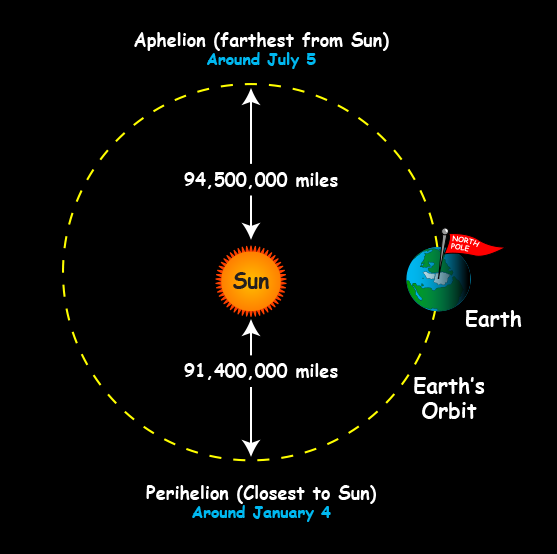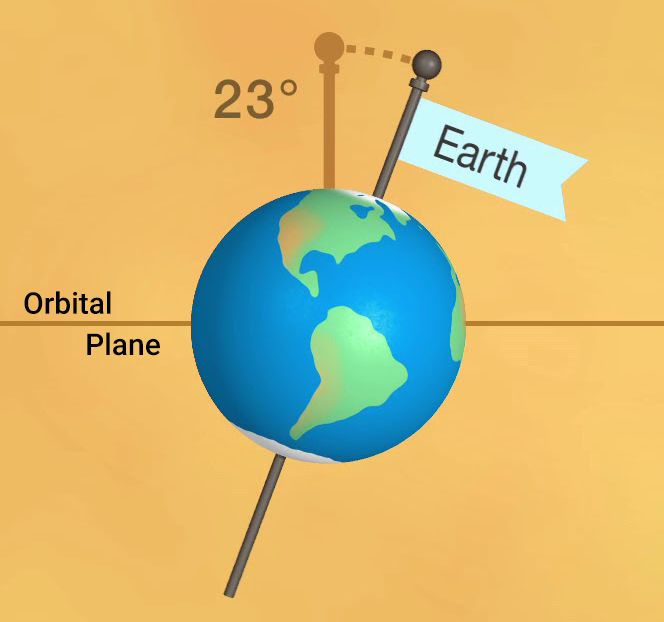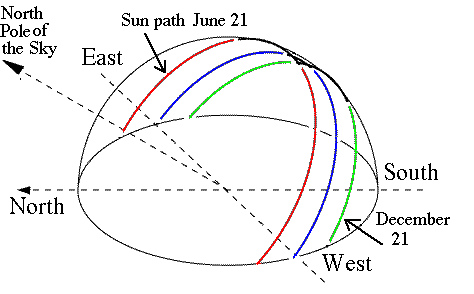The Astronomy of Christmas
My kids have been asking me what Christmas celebrates, as it’s sometimes hard to tell amidst all the trappings of magical snowmen, candy canes, decorated trees, presents, and stories of Santa Claus and his entourage of reindeer and elves. So I tell them, that Christmas celebrates the birth of Jesus Christ, the central figure of Christian religion. But Christmas is also totally an astronomical celebration. Christmas began as a celebration of the winter solstice in the northern hemisphere.
Solstices
Earth orbits the Sun in a nearly circular path. Earth’s movement in that orbit is only in 2 dimensions, so it defines a plane. Earth’s axis of spin (which defines the North Pole) is tilted at an angle relative to that plane. The angle is 66.5 degrees up from the plane or 23.5 degrees down from the perpendicular to the plane. This tilt gives rise to our seasons. Without it, the Sun would appear to rise and set from nearly the same locations every day, and the length of daylight and night from any given place on Earth would almost always be about 12 hours. Temperatures would change very little in any given location.


But, we do have a tilt. Because of it, the north pole of Earth spends half the orbit pointed generally toward the Sun and half the orbit pointed generally away (with the south pole opposite). This causes both the amount of daylight hours on any given spot to change and the rays of sunlight to impact the surface at different angles. This leads to variations in heating throughout the year that cause our seasons.

From our perspective on Earth, the location of the Sun in the sky changes with this seasonal cycle. Consider where the Sun is located in the sky at local noon on any day. During the northern hemisphere summer it reaches its highest point in the sky, it’s most northernly location. It also rises and sets from its most northernly locations on the horizon and spends the most amount of time in the sky. This is the summer solstice. The other extreme is during the winter when the Sun reaches its lowest noontime height in the sky, its most southernly location. It spends the least amount of time in the sky and rises and sets from its most southernly locations on the horizon. That is the winter solstice. The conditions are reversed for the southern hemisphere. When it is winter in the north, it is summer in the south and vice versa.


The cycle of the seasons is called the tropical year by astronomers. It is also called a solar year. It can be measured by the amount of time for the Sun to go from one winter solstice to the next winter solstice. The modern value is 365 days 5 hours 48 minutes 45.19 seconds (365.2421897 days). The solar year is not exactly the same as the amount of time to complete one orbit. Earth’s spin axis has a long-term wobble that makes the solar year a little bit shorter than the orbital year (called a sidereal year by astronomers, because it is measured by the seasonal cycle of the stars rather than the Sun). The amount of time it takes for the Earth to complete an orbit around the Sun is 365 days 6 hours 9 minutes 9.76 seconds (365.2563630 days).
The solstices occur on opposite sides of Earth’s orbit around the Sun and split the solar year in half. Halfway between each solstice is a moment when the tilt of Earth’s axis is not pointed toward or away from the Sun. These are the equinoxes, when we get equal daylight and equal night. The 2 solstices and 2 equinoxes are called the quarter days in many ancient traditions, since they divide the year up into quarters. The 4 quarter days and the days halfway between each (the cross-quarter days) have often been used as markers of the changing seasons and many festivals across many cultures have celebrated these astronomical moments.
.jpg?ver=2019-12-20-064356-537)
Solar Calendars
The calendar that most of the world uses for official time keeping, the Gregorian Calendar, is a solar calendar, synched to the cycle of the seasons. That means that solar alignments, like the winter solstice, will fall on almost the same date every year.
The Gregorian Calendar is based on the Julian Calendar, invented by the ancient Roman Empire as a solar calendar meant to simplify and replace their earlier lunar calendar. It is named for Julius Caesar and was introduced in 45 BC. It features a 4 year cycle, with three years of 365 days and a fourth year with 366 days. So each year is an average of 365.25 days. Since the true solar year is 365.2421897 days, the Julian calendar slips 1 day every 128 years. When the Julian Calendar was enacted in 45 BC the date of the spring equinox was March 25th. By the time of the first council of Nicea in 325 AD (when the Roman Catholic church began deciding official church dogma), the astronomical equinox was occuring on March 21st. By the 16th century AD, the date of the occurrence of the equinox had slipped to March 11th. This big difference from the church-decreed date of March 21st, used to determine the date of Easter, was intolerable to the Catholic church and the Gregorian Calendar was devised to fix the problem.
The Gregorian Calendar is named after Pope Gregory XIII, who enacted it in October 1582 AD. The last day of the Julian calendar was Thursday, October 4th, 1582 and this was followed by the first day of the Gregorian calendar, Friday, October 15th, 1582 (the cycle of weekdays was not affected). The Gregorian reform was to eliminate 3 leap days within every 400-year period. This new rule yields an average year length of 365.2425 days over a period of 400 years. This is a difference of 26.81 seconds from the modern value of the tropical year. It should be noted that astronomers in the 16th century knew the true value of the tropical year to higher accuracy than this. But, the church had to weigh accuracy against simplicity. Under their simple fix it takes 3,222.68 years for a 1 day slip to build up between the tropical and Gregorian cycles. So that was considered good enough.
The Date of Christmas
The first known celebrations of Christmas on December 25th occurred in Europe in the 4th century AD, using the Julian Calendar. Many historians suspect that the December 25th date was selected to coincide with pre-existing Roman festivities celebrating the winter solstice on that date. When the Julian Calendar was enacted in 46 BC the actual astronomical solstice occurred on December 23rd. But following even older traditions, the official festival for the solstice was celebrated on December 25th. By the 4th century AD, the date of the solstice had slipped in the Julian Calendar to December 21st (or the 22nd depending on the leap-day cycle), where it is located now in the Gregorian Calendar, but the festival date on the 25th remained fixed.
Many of the holidays celebrated in popular culture in the United States have a similar history: Halloween, Christmas, Groundhog Day, and Easter. They started out as festivals celebrating one of the quarter or cross-quarter days in the annual cycle of the seasons. Then, Christian holidays were associated with those older festivals. But, their dates in the Julian Calendar were not well synched to the astronomical cycle over several centuries. The Gregorian Calendar created a much better synchronization, but in many cases did not update the dates of the holidays to match their astronomical origins.
The winter solstice is my favorite holiday, because the days get longer for the next 6 months. Merry Solstice everyone!
3438